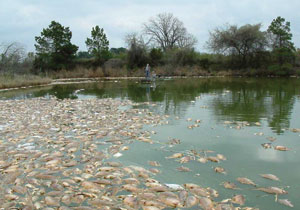RE:
SEARCH
Angling to solve algae problem

Through his research on golden algae, biology Professor James Grover works to prevent large fish kills like this one at Lake Granbury. The algae also invade fish farms and fish hatcheries.
The opportunity to catch prize-winning sport fish means big tourist dollars for Texas.
But what if the fish die off before a hook hits the water? The anglers take their tackle box—and their business—elsewhere.
Faced with large fish kills caused by the toxic algal species Prymnesium parvum, the Texas Parks and Wildlife Department called in a UT Arlington expert, biology Professor James Grover, for environmentally sound solutions.
Popularly known as “golden algae,” the microscopic species was first noticed in U.S. waters during the 1980s. It only blooms in waters that are slightly salty and is confined to the Southwest.
“Possibly it was not present in this country before the ’80s, or perhaps it was present but not problematic,” Dr. Grover said. “It’s a little bit hard to pinpoint exactly why the changes occurred.”
However, it is clear that the algae are causing significant problems now, resulting in millions of dollars in economic losses, as the fish kills occur not only in lakes, but in fish hatcheries and fish farms, important players in Texas agribusiness.
Grover and collaborators at Texas A&M, Baylor, UT Austin and the U.S. Geological Survey are particularly interested in understanding what environmental conditions help the algae become abundant and toxic.
“This is a problem in almost all lakes west of I-35,” Grover said. “I think the state would like it if we could discover something that we could just go out, put in the water and solve the problem. That might work in fish hatcheries, where they can treat all incoming waters, but it’s not practical in huge reservoirs. So I don’t think that will happen, but we may find a way to manage it, to make the algae less toxic.
“So far, we know that when the algae become stressed, they become toxic. We may find a way to put in nutrients that cause the algae to grow but that eliminate their toxicity. Or we may find that some crustaceans eat the golden algae. With that kind of biomanipulation, the algae you don’t want are suppressed by other naturally occurring organisms.”
The researchers have discovered that the algae blooms tend to start in small coves at the edge of large reservoirs. “It may be that we can knock down the bloom while it is still confined to the coves,” Grover said.
The possible solutions are many, but the desired result is well-defined: clean water; a pleasant environment; live (and lively) fish; and the continued popularity of Texas lakes.
— Sherry W. Neaves
Other Stories
Partners in discovery
Quality Enhancement Plan's pilot projects to launch this fall
Mavericks Personified: Willie Hernandez
Former Movin' Mavs star shoots for success in the wheelchair industry
Learning to serve
Many UT Arlington courses require students to perform community service. For those who enroll, it can be a life-changing experience.
Education, family style
Using their UT Arlington degrees as a foundation, the Ponce siblings fashioned successful careers in law, teaching, computing, engineering and journalism.
Morrow selected to lead women's basketball program
Contact Us
Office of University Publications
502 S. Cooper St.279 Fine Arts Building
Box 19647
Arlington, TX 76019-0647
